 |
BusTalk
A Community Discussing Buses and Bus Operations Worldwide!
|
| View previous topic :: View next topic |
| Author |
Message |
Mr. Linsky
BusTalk's Offical Welcoming Committee

Joined: 16 Apr 2007
Posts: 5071
Location: BRENTWOOD, CA. - WOODMERE, N.Y.
|
 Posted: Wed Dec 19, 2007 7:09 pm Post subject: Posted: Wed Dec 19, 2007 7:09 pm Post subject: |
 |
|
Pictured below in the foreground of this Greyhound campaign shot is fleet number 1095 – a 1940 Yellow Coach Model TD 4502 and one of 106 (1025 to 1132) delivered to Pacific Greyhound Lines in 1940 and 1941 for use in commuter service in the San Francisco Bay Area.
The TD 4502 was the first 35 foot 45 passenger bus from Yellow in what is now referred to as the ‘Old Look’ design but dubbed by GM as the ‘new model Yellow Transit’ at the time (in 1939 Yellow changed model designations and the previous model 740 of that year became the TD 4501).
Powered by Detroit Diesels coupled with mechanical transmissions, these single door coaches were fitted with standard passenger seating, window curtains and factory installed fog lights as specified on all Greyhound equipment.
Pacific Greyhound began suburban or commuter service to and from San Francisco as early as 1929 and expanded operations across the Golden Gate Bridge upon its opening in 1937.
In another expansion of service, the company moved into Marin County in March of 1941 to replace the operation of Northwestern Pacific electric trains with buses.
By 1972, Greyhound found the service to be so unprofitable that it was decided to abandon the routes which were then taken over by the newly formed Golden Gate Bridge Transit Authority (a multi county agency).
Shown in the photo below are several 4502’s awaiting passengers at a depot in San Anselmo in 1941.
Greyhound photo courtesy of Motor Bus Society.
Mr. Linsky – Green Bus Lines, Inc., Jamaica, NY
11039
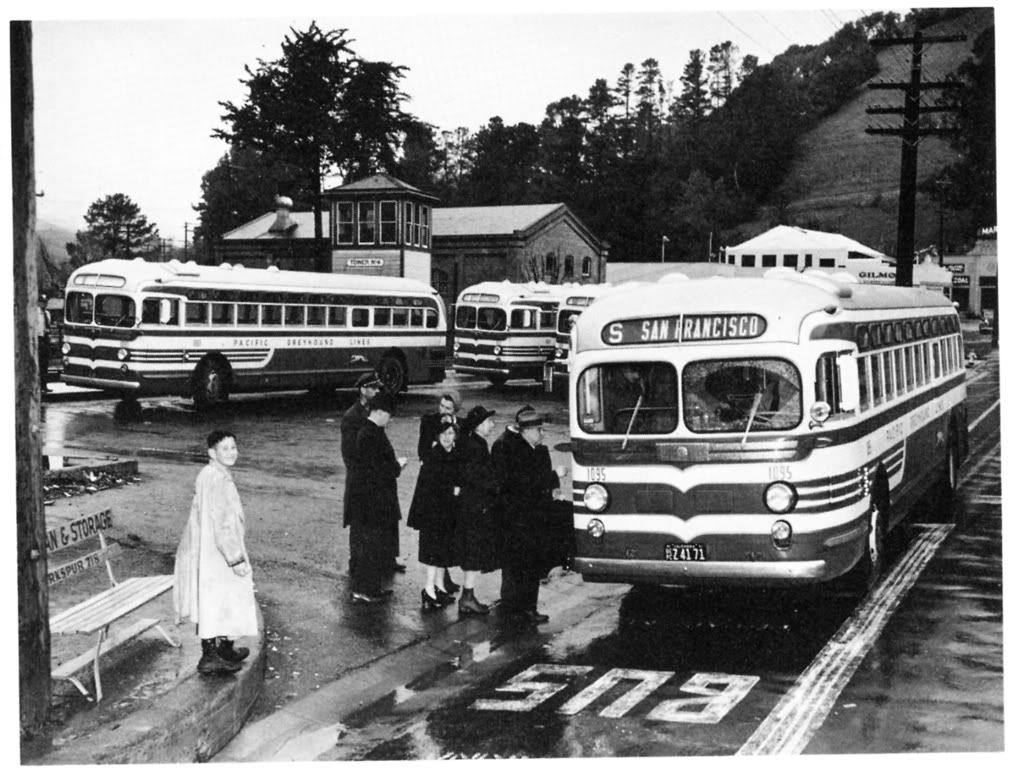 |
|
| Back to top |
|
 |
Mr. Linsky
BusTalk's Offical Welcoming Committee

Joined: 16 Apr 2007
Posts: 5071
Location: BRENTWOOD, CA. - WOODMERE, N.Y.
|
 Posted: Fri Dec 21, 2007 2:52 am Post subject: Posted: Fri Dec 21, 2007 2:52 am Post subject: |
 |
|
Pictured below in three parts is a 1952 GM campaign brochure for the 'light duty' model TGH 3101.
These 31 passenger gasoline powered coaches found a very special niche among small transit and specialty operators, and 751 were built between 1950 and 1952.
Interestingly, the first model on the second page signed for 'Corning' carries a livery very similar to Fifth Avenue Coach but I doubt that there was any relationship.
Mr. Linsky - Green Bus Lines, Inc., Jamaica, NY
11287
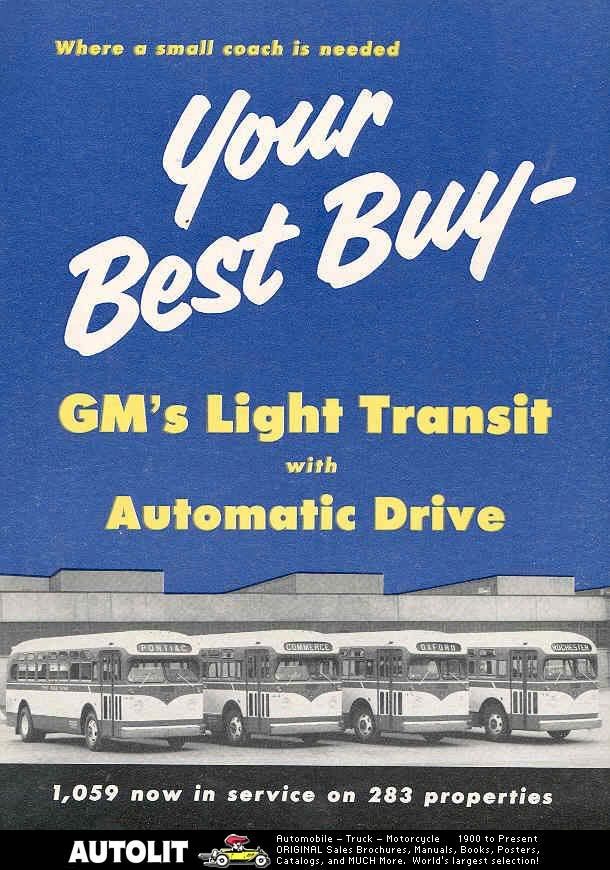
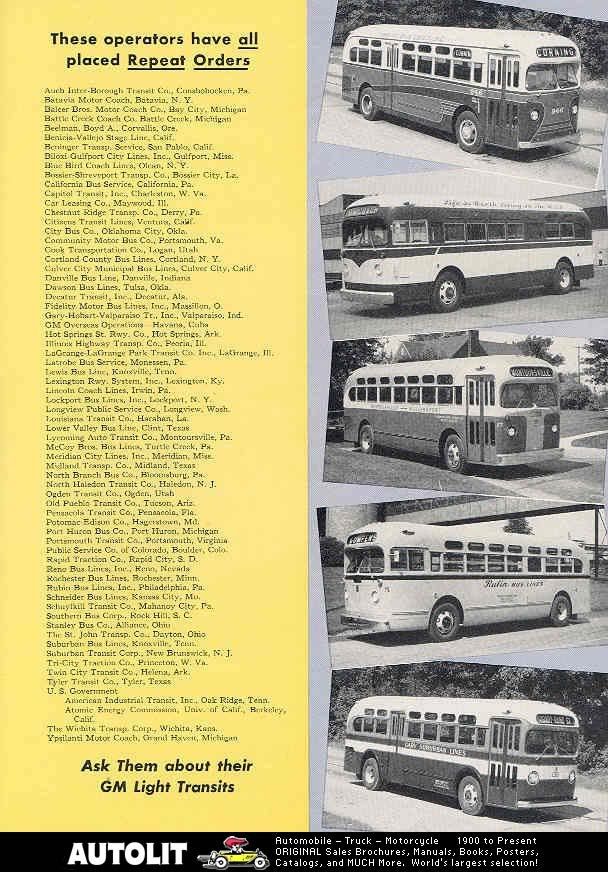
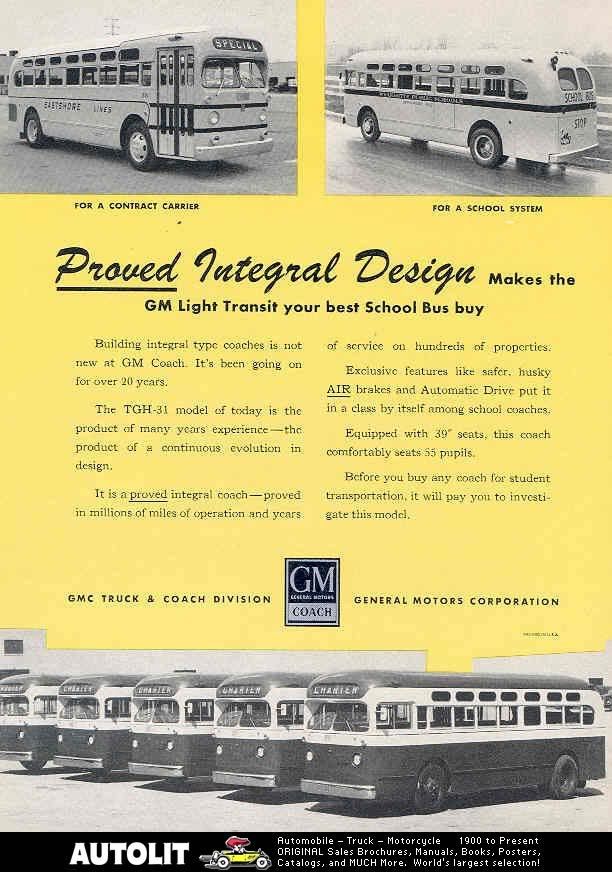 |
|
| Back to top |
|
 |
Mr. Linsky
BusTalk's Offical Welcoming Committee

Joined: 16 Apr 2007
Posts: 5071
Location: BRENTWOOD, CA. - WOODMERE, N.Y.
|
 Posted: Sat Dec 22, 2007 12:53 am Post subject: Posted: Sat Dec 22, 2007 12:53 am Post subject: |
 |
|
Pictured below is fleet number 352 – a 1927 Yellow Coach Double Decked Model ‘Z’ and one of 50 delivered to Public Service Coordinated Transport of Newark, New Jersey between 1927 and 1929.
The double decked motor coach in the U.S. has a very interesting history beginning in the early teens with Fifth Avenue Coach Manufacturing Company and was basically a copy of an already successful ‘B’ type London General.
Fifth Avenue continued to improve upon its design and by the time it sold its manufacturing arm to Yellow Coach in the mid twenties its ‘L’ model low floor 55 passenger version had been well received by major operators across the country.
Yellow’s model ‘Z’, which first appeared in 1925, was the culmination of the best of both the model ‘K’ that it had already been producing for Chicago Motor Coach (a sister company to Fifth Avenue) and Fifth Avenue’s model ‘L’.
At almost 29 feet in length with seating for as many as 71 passengers (depending on configuration) and at a cost of over $14,000 each, the Model ‘Z’ was powered by a very unusual gas/electric design explained more fully in the Yellow Coach magazine advertisement accompanying the photo below.
The Public Service order was the last of the model Z’s to be manufactured with most going to the Penn-Jersey Rapid Transit routes and some subsequently running for Newark.
# 352 photo courtesy of Motor Bus Society.
Mr. Linsky – Green Bus Lines, Inc., Jamaica, NY
11530

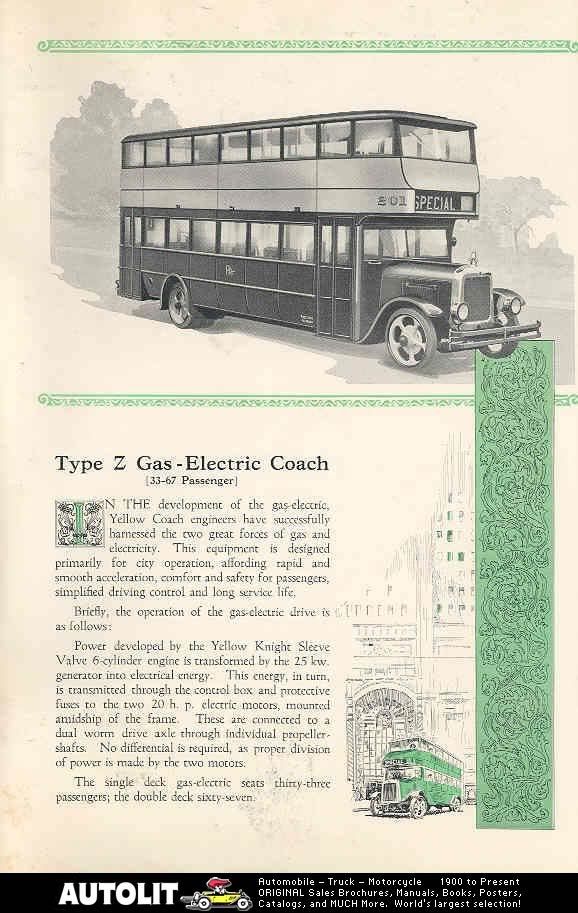 |
|
| Back to top |
|
 |
nycbusfan

Joined: 16 Apr 2007
Posts: 258
Location: Brooklyn, NY
|
 Posted: Sat Dec 22, 2007 9:02 pm Post subject: Posted: Sat Dec 22, 2007 9:02 pm Post subject: |
 |
|
That bus looks very similar to a FACCO Double Decker that I was able to ride at Last summers bus roadeo. I also saw that bus on display at Bus Fest and in Times Square on Decmber 10th.
Here are some photos I took of that bus and a flyer that I got from the bus when it was on display in Times Square.




I also have more flyers like this, a few old pictures and some vintage ads which I will post when I get a chance. |
|
| Back to top |
|
 |
Mr. Linsky
BusTalk's Offical Welcoming Committee

Joined: 16 Apr 2007
Posts: 5071
Location: BRENTWOOD, CA. - WOODMERE, N.Y.
|
 Posted: Sun Dec 23, 2007 3:10 am Post subject: Posted: Sun Dec 23, 2007 3:10 am Post subject: |
 |
|
nycbusfan,
Great pictures of FACCO # 1263.
These Z's were the next and last of their generation (basically the same 'Z' chassis with a much more modern body).
The next and even more modern versions came in 1936 and were designated as 720's and 735's (dubbed the 'Queen Marys) and had rear mounted Diesel engines with Banker semi automatic transmissions.
While I remember the last of the Z's, I never rode one but did ride the 700's both open topped and closed many times as a kid (those were the days when Fifth Avenue was two way).
Pictured below is the very first ever Fifth Avenue double decker built in 1910 and shown on Riverside Drive at that time (notice that it appears to have a large Mercedes logo in front of the radiator).
Also found another late 'Z' (# 1244) from the same batch as 1263 (notice the solid tires).
Those buses were built so well and were so reliable that they could still be running today!
Thanks for sharing.
Photos courtesy of MTA archives.
Mr.Linsky - Green Bus Lines., Jamaica, NY
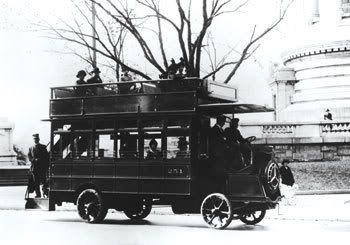 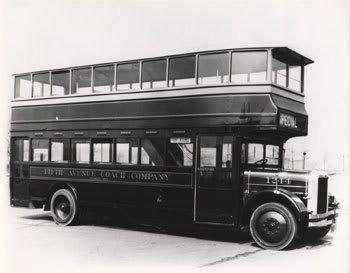 |
|
| Back to top |
|
 |
Mr. Linsky
BusTalk's Offical Welcoming Committee

Joined: 16 Apr 2007
Posts: 5071
Location: BRENTWOOD, CA. - WOODMERE, N.Y.
|
 Posted: Tue Dec 25, 2007 7:35 pm Post subject: Posted: Tue Dec 25, 2007 7:35 pm Post subject: |
 |
|
Pictured below are two field photos of fleet number 942 – a 1947 GM TDH 4507 (ser# 0867) and one of 25 (926 to 950) delivered to Green Bus Lines of Jamaica, New York in June and July of that year.
The TDH 4507 was basically an update of TD 4506 model which was the first post war 45 passenger transit from GM and appeared in June of 1945 and continued production through 1946.
New features on the 4507 included a Thermo-Matic heating and ventilation system (obvious by the air intake over the destination sign), an effort to reduce excessive engine noise with the use of insulated rear engine hatches, and the introduction of the treadle step operated rear door (passenger activated).
Manufactured between November 1946 and September 1948, these 35 foot long, 96 inch wide coaches sported Detroit 6-71 Diesels combined with hydraulic transmissions and a total of 3,045 were produced with the largest single orders going to Baltimore Transit Company (199) and Key System Transit Line of Oakland California (149).
While these buses were solidly built and reliable, drivers, at least at Green Line, complained bitterly about the ineffectiveness of the Thermo-Matic heating system which delivered warmth only through ducts mounted above the transom windows (a later order for ten additional 4507’s were equipped with standard floor heaters as backup).
Interestingly, Green Line’s original 25 4507’s were diverted from a 100 bus order placed by Surface Transportation – notice the old fashioned city type headlamps (a Surface trademark) which were also ineffective in suburban operation and were quickly replaced with sealed beams.
A personal note; I drove most of the 4507’s at Green Line at one time or another and, while they couldn’t get out of their own way, they kept on ticking through the early sixties when what was left of them went to Jamaica Buses.
BTW; those white slips in the transom windows of the top photo were fare increase notices.
You may also note in the background of the lower photo a couple of Green Line's late thirties model 'CT' Macks that were still operating in Rockaway.
Upper photo courtesy of Green Line archive.
Lower photo courtesy of Dennis M. Linsky of GMOldLookBus.
Mr. Linsky – Green Bus Lines, Inc., Jamaica, NY
12446
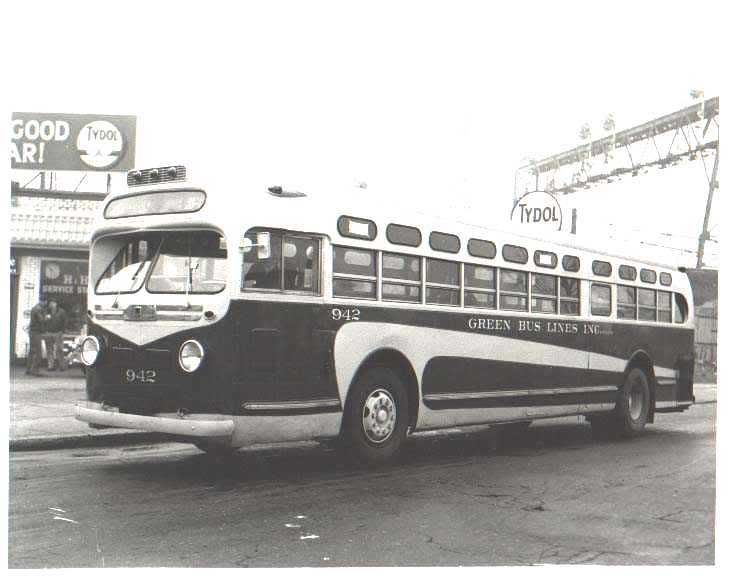
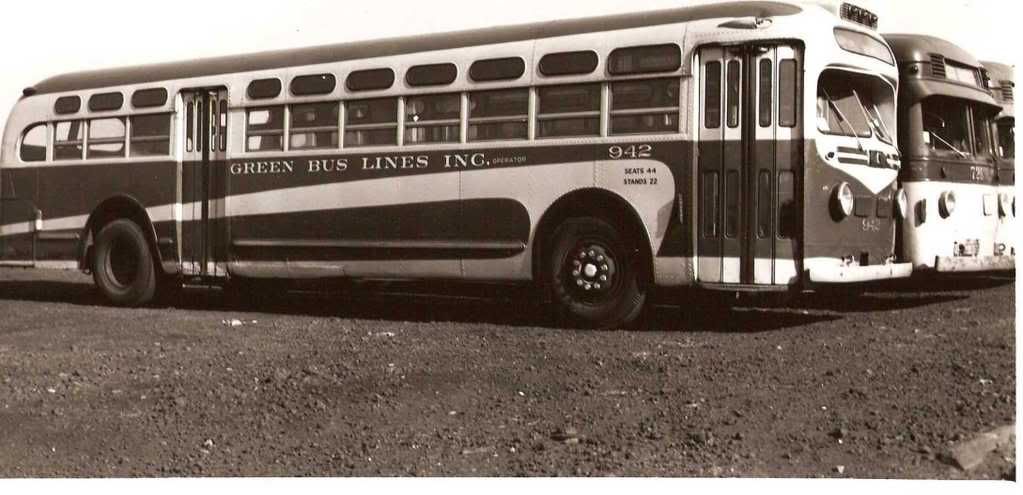
Last edited by Mr. Linsky on Wed Dec 26, 2007 3:03 am; edited 5 times in total |
|
| Back to top |
|
 |
gmnewlook
Age: 52
Joined: 02 Nov 2007
Posts: 67
Location: Montreal, QC
|
 Posted: Tue Dec 25, 2007 11:52 pm Post subject: Posted: Tue Dec 25, 2007 11:52 pm Post subject: |
 |
|
| Mr. Linsky wrote: | Pictured below is the very first ever Fifth Avenue double decker built in 1910 and shown on Riverside Drive at that time (notice that it appears to have a large Mercedes logo in front of the radiator).
|
I don't think it' s a Mercedes logo, I have a book, "Les 100 and du bus" from the RATP in Paris and their first buses from 1906 had the same kind of radiator and they were built by Brillié-Schneider and later Schneider. |
|
| Back to top |
|
 |
Mr. Linsky
BusTalk's Offical Welcoming Committee

Joined: 16 Apr 2007
Posts: 5071
Location: BRENTWOOD, CA. - WOODMERE, N.Y.
|
 Posted: Wed Dec 26, 2007 2:41 am Post subject: Posted: Wed Dec 26, 2007 2:41 am Post subject: |
 |
|
gmnewlook,
You're absolutely right; the bus in the picture is a 1909 Model P2 Brillie Schneider.
Now that I think about it, I seem to remember a 'French Connection' very early on in Fifth Avenue Coach history and probably before they started to build their own buses.
I suppose Schneider's years of experience building military tanks helped when he met up with Brillie at the turn of the century and started building buses (that looked like tanks!).
I have attached some interesting pictures of Brillie Schneider buses of the era below.
Photos courtesy of SymBioz Transports en Commun.
Mr. Linsky - Green Bus Lines, Inc., Jamaica, NY
12537
 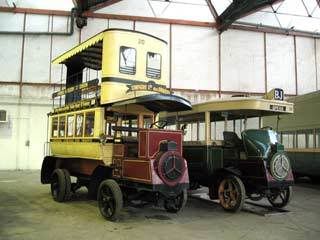  |
|
| Back to top |
|
 |
Mr. Linsky
BusTalk's Offical Welcoming Committee

Joined: 16 Apr 2007
Posts: 5071
Location: BRENTWOOD, CA. - WOODMERE, N.Y.
|
 Posted: Sat Dec 29, 2007 1:04 am Post subject: Posted: Sat Dec 29, 2007 1:04 am Post subject: |
 |
|
Pictured below is fleet # D900 – an experimental 1950 GM Model TDH 4509 (ser# 0699) and delivered to Public Service Coordinated Transport of New Jersey in May of that year.
This bus was not your father’s Oldsmobile (so to speak!). The D900 (dubbed by GM as a ‘Reverse All-Service Bus) was a collaboration between engineers and designers at both the factory and PSNJ to fabricate a vehicle which would actually be two independently powered buses within one body.
You can throw your ideas of ‘Hybrid’ or Diesel Electric (of any type) right out the window because when this coach plied a non-electrified route, it operated as a pure TDH having nothing to do with its second source of motive power.
However, when called upon for duty as a trolley bus (in this case to service the abandoned Newark subway system), the power poles were raised to meet the overhead grid and, simply put, a switch was toggled to shut down the Diesel and begin electric motive operation.
The secret of success in the development of the ‘RASB’ was the common drive rear axle which, in this case, sported two independent ‘drive’ bowls (one for electric and the other for Diesel).
The left hand bowl housed a conventional differential assembly while the right hand bowl (experimental) housed a double reduction 90-degree drive without differential and was connected to a large electric motor.
A sliding clutch was used as a means of transferring operation from one bowl to the other.
GM’s cost to PSNJ for its engineering, development and delivery of the D900 prototype was $55,000 but would be reduced to just over $25,000 per unit for an expected delivery of 72 production models;
Some ‘raw facts’ on the D900;
Seating; 43, Overall length; 35’8”, Width; 96”, Height 132”, Weight; 21,740lb, Diesel engine; 6V-71, Transmission; Hydraulic, Electric Motor; GE 1204B1.
Modifications; (as per New Jersey law and PSNJ specification);
Reinforced overhead and side steel panels adjacent to rear door and emergency door instead of aluminum, Wood passenger doors instead of steel, Rubber insulated stanchions, Rear bumper extended to clear overhead pole retrievers.
Because of both political and logistical problems, the D900 never actually saw revenue service as a trolley and was eventually stripped of its electric propulsion equipment and did serve for a number of years as a standard TDH 4509 from PSNJ’s Greenville Garage in Jersey City.
The complete story of the D900 may be found in the September/October 1992 Motor Coach Age.
Photos courtesy of the Motor Bus Society.
Mr. Linsky – Green Bus Lines, Inc., Jamaica, NY
13154
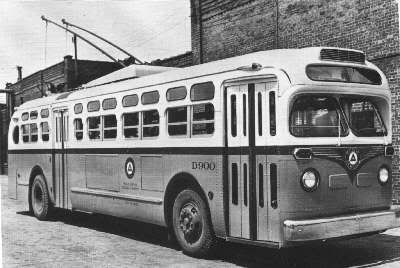
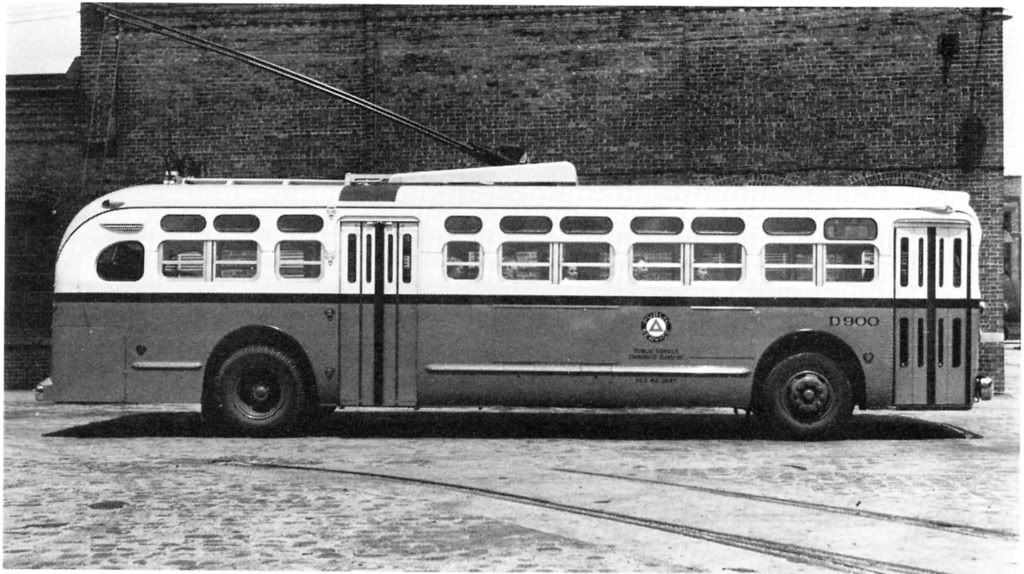 |
|
| Back to top |
|
 |
Bill D

Joined: 17 Apr 2007
Posts: 332
Location: Waterbury, CT
|
 Posted: Sat Dec 29, 2007 6:25 am Post subject: Posted: Sat Dec 29, 2007 6:25 am Post subject: |
 |
|
| Mr. Linsky wrote: | Bill,
Great great picture of Springfield ACF # 170 - I don't think I have ever seen a rear mounted spare tire on a modern era transit before - they were really not necessary on local routes with the immediate availability of service cars.
It appears as though the name 'Springfield' and the numbers are arranged in the same block form as both 'Berkshire' and Connecticut' - was there a relationship?
Interestingly, Berkshire Street Railway did run a number of ex Connecticut ACF's as follows;
1937 ACF Model H-13-S Fleet # 112 & 113
1937 ACF Model H-17-S Fleet # 114 to 116 (ser# 281, 282 & 284) Ex Conn. # 490, 491 & 493.
However, no mention is made of any conncetion with Springfield.
Mr. Linsky - Green Bus Lines, Inc., Jamaica, NY |
Mr. Linsky,
I came across another book by R. Patrick Stanford, titled "Lines of The New York, New Haven and Hartford Railroad Co.", which contains a section detailing the railroad's transit holdings. Operations owned by the New Haven included:
The Connecticut Company
The Rhode Island Company
The Vermont Company
Berkshire Street Railway Company
Westchester Street Railroad Company
New York and Stamford Railway Company
County Transportation Company
Soundview Transportation Company
Springfield Street Railway
Worcester Consolidated Street Railway Company
New England Transportation Company
As you can see, the New Haven seemed to control most local services paralleling its' rail lines, except in the New York City and Boston areas. I found it interesting that the railroad gained a strong foothold in Westchester County, especially in White Plains. The significant holding there was Soundview Transportation, which the New Haven acquired from the New York, Westchester and Boston Railroad in 1938, when the assests of the later company were being liquidated.
This should explain the relationship between the companies which you had mentioned.
Bill |
|
| Back to top |
|
 |
Mr. Linsky
BusTalk's Offical Welcoming Committee

Joined: 16 Apr 2007
Posts: 5071
Location: BRENTWOOD, CA. - WOODMERE, N.Y.
|
 Posted: Sun Dec 30, 2007 3:50 am Post subject: Posted: Sun Dec 30, 2007 3:50 am Post subject: |
 |
|
The following recounts the earliest history of Fifth Avenue Coach in New York and contains information with concern to their first motorized coaches of European origin (and possibly of the Brillie-Schneider design that had been discussed and illustrated previously in this forum).
Fifth Avenue Coach was, if not the first, certainly among the first motorized transit operations in the United States in 1907.
At the time there were vitually no U.S. bus manufacturers of any consequence other than Mack, and their endevours were not yet producible on any grand scale (Mack came into its own in bus manufacture in the mid teens).
It was about that time that Fifth Avenue began its own manufacturing mainly of double decker buses in shops in uptown Manhattan for proprietary use and for other independent operations across the country.
An alliance with Yellow Coach Manufacturing Company of Chicago in the mid twenties ended the company's short history as a coach builder.
The below information has been provided by the New York Historic Society;
Historical Note
The Fifth Avenue Coach Company, incorporated in 1896, was a horse-drawn omnibus line originally founded in 1885 as the Fifth Avenue Transportation Company (Ltd.) to discourage the laying of trolley tracks on the fashionable two-way thoroughfare. Battery operated vehicles were quickly abandoned after their introduction in 1900 as a result of their expense and inefficiency. Horse-drawn London-type omnibuses continued to be used until 1907, when they were replaced by gasoline-driven motor coaches with French engines and London chassis. The company began producing their own motor coaches in 1914 and became well known for their double-decker models.
The Fifth Avenue Coach Company became a subsidiary of the Third Avenue Railway Company in 1898 and the New York Transportation Company in 1899, gaining its independence in 1912. In 1924 it became a subsidiary of the Omnibus Corporation, which controlled the bus systems in New York and Chicago. In 1954, after acquiring the Hertz car rental business, the Omnibus Corporation sold the assets of the Fifth Avenue Coach Company to the New York City Omnibus Corporation, which was renamed Fifth Avenue Coach Lines in 1956. After a strike in 1962, the company's bus operations were taken over by the city.
Mr. Linsky - Green Bus Lines, Inc., Jamaica, NY |
|
| Back to top |
|
 |
HwyHaulier
Joined: 16 Dec 2007
Posts: 932
Location: Harford County, MD
|
 Posted: Mon Dec 31, 2007 1:07 pm Post subject: Posted: Mon Dec 31, 2007 1:07 pm Post subject: |
 |
|
| Mr. Linsky wrote: | | Pictured below in the foreground of this Greyhound campaign shot is fleet number 1095 – a 1940 Yellow Coach Model TD 4502 and one of 106 (1025 to 1132) delivered to Pacific Greyhound Lines in 1940 and 1941 for use in commuter service in the San Francisco Bay Area.... |
Mr. Linsky -
Thanks for the account of Pacific G L, Bay Area, Marin County services. There's another site around, now apparently dormant, that took a try at it, but
didn't have the detailed accounts of the period you covered.
Another item... Double Deckers? Guess they worked well in another time, and another place. These days, the large operators now with every appearance
of deep pockets. Then, the phenomena there is no shortage of members of the bar, to enable chasing down endless perceived grievances. I can't get the
arithmetic to work anymore. Possible cases of riders slipping on carelessly discarded slices of pizza, and they win the Life Lottery?
.........................Vern................. |
|
| Back to top |
|
 |
Mr. Linsky
BusTalk's Offical Welcoming Committee

Joined: 16 Apr 2007
Posts: 5071
Location: BRENTWOOD, CA. - WOODMERE, N.Y.
|
 Posted: Tue Jan 01, 2008 12:35 am Post subject: Posted: Tue Jan 01, 2008 12:35 am Post subject: |
 |
|
HwyHaulier,
Now that the champagne and lobsters are put away, I can get back to work for 2008! (Happy New Year!).
I think the main reasons for Fifth Avenue Coach discontinuing DD service in 1953 (Chicago had alraedy done so some years before) were the rising costs of fuel, maintenance and the difficulty in obtaining parts.
However, your supposition concerning liability is well taken;
The double deckers were one man operations making it almost impossible for the operator to know what was occuring on the second level.
I would also doubt seriously that any driver took the time to tour the upstairs on layovers to check for banana peels and the like!
It's too bad that those buses have gone because they were such an important part of New York's history.
Just a stroll down memory lane below (for educational purposes only).
Mr. Linsky - Green Bus Lines., Inc., Jamaica, NY
13837
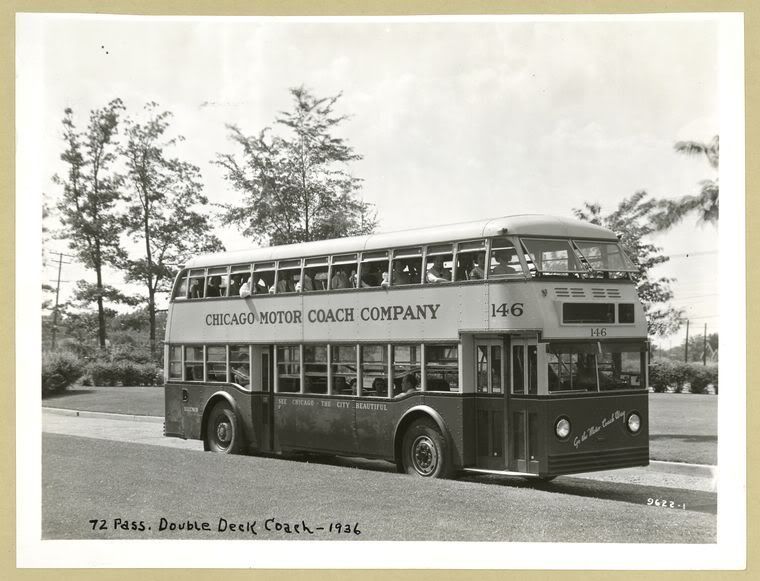 |
|
| Back to top |
|
 |
Mr. Linsky
BusTalk's Offical Welcoming Committee

Joined: 16 Apr 2007
Posts: 5071
Location: BRENTWOOD, CA. - WOODMERE, N.Y.
|
 Posted: Wed Jan 02, 2008 3:30 am Post subject: Posted: Wed Jan 02, 2008 3:30 am Post subject: |
 |
|
Pictured below is fleet number 146 – a Yellow Coach Model 720 and one of 140 (104 to 244) delivered to the Chicago Motor Coach Company between 1936 and 1938.
Referred to as a ‘Queen Mary’, the double decked model 720, along with its almost identical model 735 were the last such coaches to be produced by Yellow for both Chicago Motor Coach and New York’s Fifth Avenue Coach (both subsidiaries of the Omnibus Corporation) with a total of 300 built before production ended in 1938.
Engineering for these 72 passenger models was, at the time, a departure from convention with the placement of a 616 cubic inch gasoline engine transversely mounted at the rear and combining it with both a newly patented 90 degree ‘angle drive’ and fully automatic ‘Banker’ transmission to an off-set differential.
This configuration made for easier access to the engine, greater utilization of space within the bus body and became the standard by which almost all transit and over the road coaches are manufactured today.
Some interesting features included; full headroom on both decks, comfortable deeply upholstered seating, ‘double stream’ front doors with ‘low floor’ first level, a wide unobstructed stairway behind the driver, and perfect weight distribution (2/3 rear – 1/3 front) providing exceptional ride qualities.
Also note that some model 720’s built for Fifth Avenue were slightly lower than the just under 13 foot standard height to navigate the el structures on the Jackson Heights Route 15 line.
While most of the surviving 720’s and 735’s were converted to ‘71’ series Detroit Diesels after the war, increased labor costs and reduced passenger volume saw the end to their service for Chicago in 1950 and for New York in 1953.
These were grand old coaches befitting the title of ‘Queen Mary’, and have taken a very prominent place in the history of bus transportation.
Photos borrowed for educational purposes only.
Mr, Linsky – Green Bus Lines, Inc., Jamaica, NY
14086

 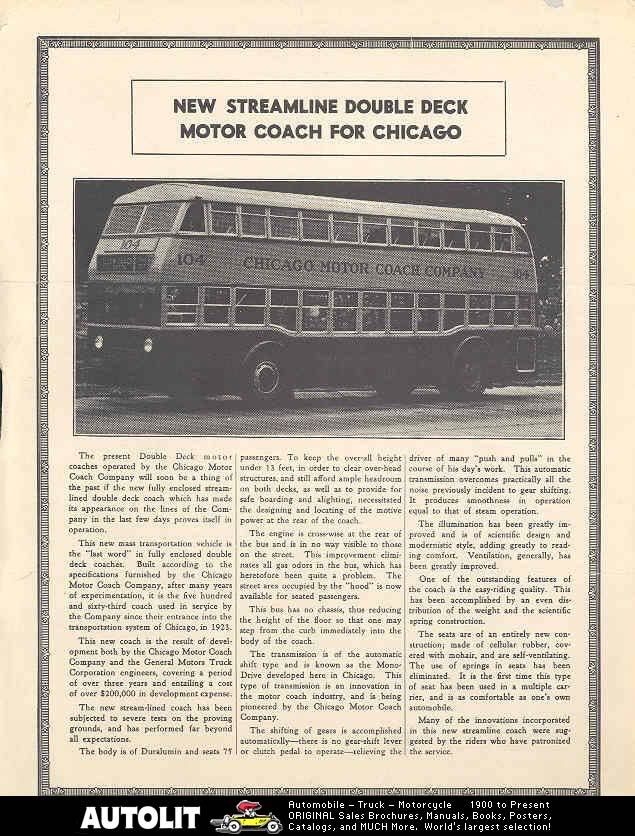 |
|
| Back to top |
|
 |
HwyHaulier
Joined: 16 Dec 2007
Posts: 932
Location: Harford County, MD
|
 Posted: Wed Jan 02, 2008 7:58 am Post subject: Posted: Wed Jan 02, 2008 7:58 am Post subject: |
 |
|
Mr. Linsky -
Many Thanks for the comprehensive discussions of the PSNJ ASV, and the New York and Chicago Double Deck designs...
It supports the point I was trying to illustrate in my criticism (yesterday) of the largely unsupported nonsensical and inflammatory attacks against GM.
Seems as no one in that particular claque of critics is about to begrudge that GM may have done a lot of all of it the old fashioned way. They just
worked harder at better engineering. Much of the other asserted transgressions were just stuff that had been perfected earlier by, oh, let's think
Southern Pacific and Pennsylvania Railroads...
............................Vern..................... |
|
| Back to top |
|
 |
|
|
You cannot post new topics in this forum
You cannot reply to topics in this forum
You cannot edit your posts in this forum
You cannot delete your posts in this forum
You cannot vote in polls in this forum
You can attach files in this forum
You can download files in this forum
|
Powered by phpBB © 2001, 2005 phpBB Group
|
























